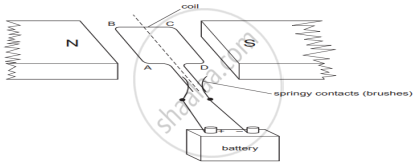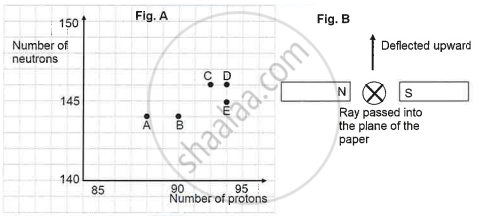Advertisements
Advertisements
Question
When is the force experienced by a current-carrying conductor placed in a magnetic field largest?
Solution 1
According to Fleming's left hand rule, the force exerted on a current carrying conductor placed in a magnetic field is maximum when the conductor is placed perpendicular to the magnetic field. That is, the direction of the electric current and the direction of the magnetic field are perpendicular to each other.
Solution 2
When the direction of the current is perpendicular to the direction of the magnetic field, the force that a current-carrying conductor experiences in a magnetic field is greatest.
APPEARS IN
RELATED QUESTIONS
A positively-charged particle (alpha-particle) projected towards west is deflected towards north by a magnetic field. The direction of magnetic field is ______.
State qualitatively the effect of inserting an iron core into a current-carrying solenoid.
What type of core should be put inside a current-carrying solenoid to make an electromagnet?
The diagram given below represents magnetic field caused by a current-carrying conductor which is:

(a) a long straight wire
(b) a circular coil
(c) a solenoid
(d) a short straight wire
For Fleming's left-hand rule, write down the three things that are 90° to each other, and next to each one write down the finger or thumb that represents it.
State two ways to increase the force on a current-carrying conductor in a magnetic field.
Name one device whose working depends on the force exerted on a current-carrying coil placed in a magnetic field.
What is the force on a current-carrying wire that is parallel to a magnetic field? Give reason for your answer.
How will the direction of force be changed, if the current is reversed in the conductor placed in a magnetic field?
State two ways to increase the speed of rotation of a D.C. motor.
Name and state the rule of determine the direction of force experienced by a current carrying straight conductor placed in a uniform magnetic field which is perpendicular to it.
Which of the following factors affect the strength of force experience by current-carrying conduct in a uniform magnetic field?
For a current in a long straight solenoid N- and S-poles are created at the two ends. Among the following statements, the incorrect statement is
Describe the activity that shows that a current-carrying conductor experiences a force perpendicular to its length and the external magnetic field. How does Fleming’s left-hand rule help us to find the direction of the force acting on the current carrying conductor?
A simple motor is made in a school laboratory. A coil of wire is mounted on an axle between the poles of a horseshoe magnet, as illustrated.

In the example above, coil ABCD is horizontal and the battery is connected as shown.
- For this position, state the direction of the force on the arm AB.
- Why does the current in the arm BC not contribute to the turning force on the coil?
A current-carrying conductor of a certain length, kept perpendicular to the magnetic field experiences a force F. What will be the force if the current is increased four times, the length is halved and the magnetic field is tripled?
Which of the following pattern correctly describes the magnetic field around a long straight wire carrying current?
Two LED bulbs of 10W and 5W are connected in series. If the current flowing through 5W bulb is 0.005A, the current flowing through 10W bulb is ______.
|
The graph (fig A) illustrates the correlation between the number of protons (x-axis) and the number of neutrons (y-axis) for elements A, B, C, D, and E in the periodic table. These elements are denoted by the letters rather than their conventional symbols. When the element C, depicted in the graph, undergoes radioactive decay, it releases radioactive rays. When these rays are directed into the plane of the paper in the presence of a magnetic field, as indicated in the fig B, they experience deflection, causing them to move upwards.
|
Name the law used to identify the radioactive radiation emitted by the element.

